The first introvert in a shaking world
Each new film about space is a chance to interest people with what cosmonautics is beautiful with . And, theoretically, the biopic "First on the Moon" ("First Man", KinoPoisk , IMDB ), telling about the life of Neil Armstrong, had every chance - the only authorized biography as a source, director Damien Chazell, who shot "La La Land" , Armstrong's really interesting life, which, besides Apollo 11, piloted Gemini 8 (the first in the history of docking) and flew X-15 rocket aircraft. Even the fact that the film was released more than six months before the half-century anniversary of the landing on the moon, gave hope that the picture was not removed to a round date and could make a good one. Alas, in my opinion, it turned out badly.

It is difficult to call the spoilers biography of Armstrong, but, just in case, you were warned.
First of all - the picture confidently took the first place of my anti-rating of physical uncomfortable viewing. The camera is so mercilessly shaking that from the film really swayed! And if the shaking in scenes with aircraft and spacecraft can be attributed to an attempt to show a realistic vision of what happened, then the shaking domestic scenes have no rational explanation. As a result, my wife was forced to keep her eyes closed for more than half the film. I was hardier, but the whole movie felt distinct physical discomfort.
')
There is a feeling that Shazell decided to create a conceptual art house, deliberately taking it off his hands, at a time when every video blogger has a smartphone on a stabilizing gimbal. In general, looking ahead, the film lacks what it seemed to me to be signs of an arthouse. There is a second option - the director decided to prepare the audience for an astronaut career and made a vestibular apparatus test out of the picture. In any case, on the poster you should write a warning, like on a carousel.
It so happened that the shortcomings of the film are revealed in the first scene of the flight on the X-15 and then just repeat.
First of all, Armstrong is shown very lonely. But the test or space flight is a joint effort of many people. The crew of the aircraft carrier, personnel on the ground - all these people are compressed to occasionally audible voices on the radio. The test flight of Chuck Yeager in “The Right Stuff” is shown much more correctly.
Further, the X-15 cab looks very unfriendly - there are windows on the screen from which nothing is clearly visible, incomprehensible devices and too often just a body with fastener elements is shown. It turns out psychologically unreliable image, because Armstrong studied the design and operating rules of the rocket plane, and the cabin for him should have been familiar and understandable. It seems that the X-15 is shown to us not by test pilot Armstrong, but by the humanities scriptwriter / director / operator.
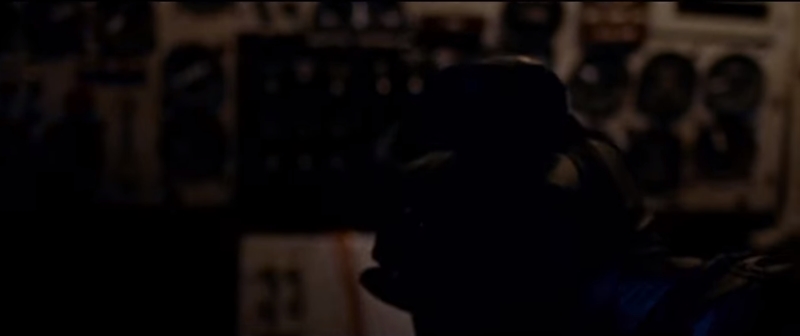
Frame from the film
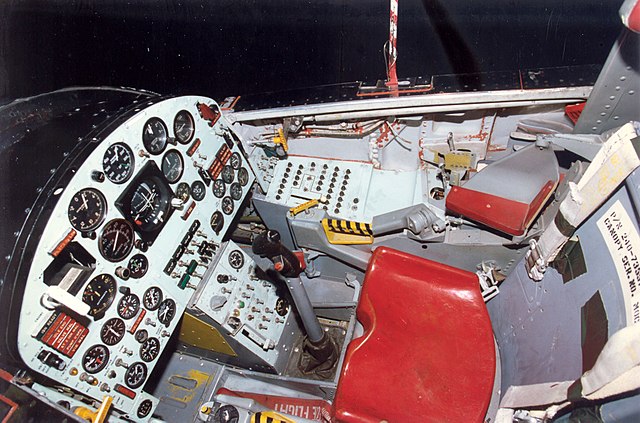
Real cabin X-15. Much cozier. Photo of US Air Force Museum
The world outside is no better - the solar stratosphere is shown to us as a gloomy and overcast day. Compare the footage from the film and the real chronicle of the flight of the X-15.
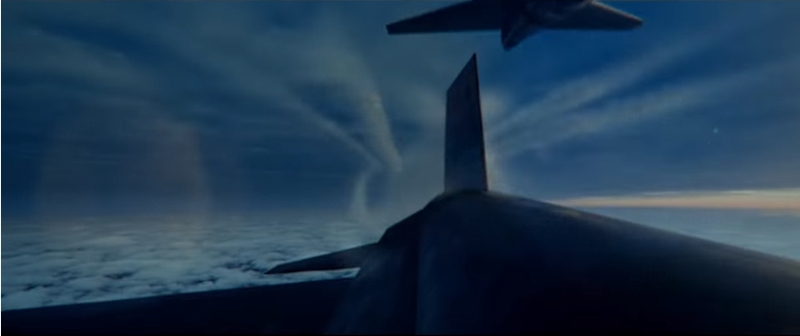
Frame from the film
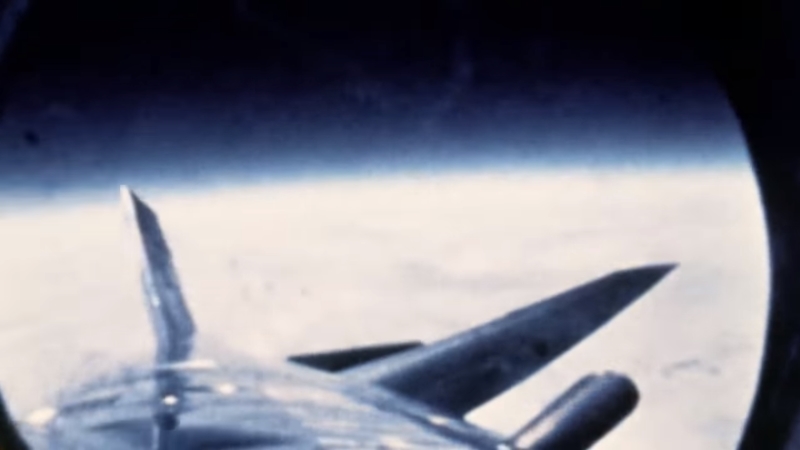
A shot from the filming of the real X-15's onboard camera
And finally, what is happening in the film is understandable only to the boom, who understands the topic, because almost nothing is explained - what happens to whom and why. Some remarks, possibly degraded by translation, generally look like a mistake, and you need to specifically clarify in the sources in order to find out that in the film we are shown a badly retold real story.
In the scene of a flight on the X-15, Armstrong itself begins to grow in height, and he is informed that he rebounds from the atmosphere. Since the speed of the suborbital rocket plane, this seems to be a serious mistake, since ballistics requires that, rising on a rocket engine over the dense layers of the atmosphere, but not going into orbit, the X-15 will go back. What was really?
The film shows 51 flights of the X-15, it is 3-4-8 (aircraft number 3, fourth flight, 8 taking into account towing and cancellations), which occurred on April 20, 1962. His goal was to test the adaptive control system MH-96. What is this system? The entire first half of the 20th century in aviation control was direct - the handle in the cockpit is connected by cables with control surfaces. This is simple, but has a serious drawback - at different speeds and flight modes, different efforts and movements of the knob are required to achieve the same effect. The MH-96 was an experimental system that was placed between the control stick in the cockpit and control surfaces on the wings and tail unit. Her task was to ensure the same reaction apparatus to move the handle, regardless of how much you need to move the control surface. Now such systems (EDSU) are on a variety of aircraft - airbuses, starting with the A320, Tu-204, Sukhoi Super Jet and the vast majority of military vehicles, but in the 1960s this was a new direction, and the X-15 flying in a large speed range and heights, was the perfect test bench.
Armstrong's mission in this flight was to check the MH-96 overload limiter. To prevent the rocket plane from falling apart in the air, the MH-96 had to independently control the X-15, reducing the overload. According to the plan, tested on the simulator, Armstrong had, after climbing, to hold the rocket glider up to about 15 ° with his nose. When descending, this would create an overload of 4-4.5 "same", sufficient to enable MH-96 to turn on and automatically lower the nose down. Initially, the flight went according to plan, and, rising to 63 km, Armstrong oriented the X-15 face up and waited. Alas, the simulation was incorrect - the adaptive control system did not turn on. And, since the X-15 is a winged vehicle, it, having a suborbital speed and a positive pitch angle, pushed its wings away from the dense layers of the atmosphere and really began to gain altitude. Having become a visual model of the Zenger bomber , the rocket flight with Armstrong could have flown far, but this was precisely what had to be avoided. The fact is that the X-15s landed on dry lakes, while Armstrong shifted from them all further south. Therefore, from the ground, the Nile was handed “We see that you are rising, not turning. Perform a steep left turn! ”But the rocket glider was outside the dense layers of the atmosphere, there was not enough air pressure to turn the device. After some time, going down below, Armstrong was able to deploy the X-15 in a sharp turn with an overload of 3 "same" and returned safely to the base. He even had a small reserve of height, the speed of which had to be extinguished by the release of brake flaps at the landing. But, of course, rumors have spread that Armstrong flew just meters above the houses of the village located south. A flight 3-4-8 was a record for the duration of the test program X-15.

Blue is a planned trajectory, red is a real reconstruction. A source
Returning to the film, we were correctly shown the events, but, without explanation, they look incomprehensible and implausible. Perhaps the filmmakers reproduced the dialogues verbatim, but it would be better for the on-screen Armstrong to comment on what was going on, since the pilot’s ongoing report is a logical and expected thing under test flight conditions.
The fact that the Armstrong family had a two-year-old daughter died of cancer is little known. The fact that he was reflected in the film is good and right, but instead of the emotional coloring of the life of the Hero of Humanity, something completely different happened. Memories of his daughter appear on the screen at critical moments, and the relationship with his wife is shown as problematic. And as a result, it begins to seem that the whole film is about how the father lost his daughter, and, along with her, the whole point of later life, in a completely incomprehensible way, in parallel becoming an astronaut and landed on the moon.
The final scene, when Armstrong leaves the bracelet of his dead daughter on the Moon, is based on the words of his sister June (June), indicated in the biography. She expressed the hope that Armstrong left something on the moon in memory of her daughter. At the end of the lunar surface, Armstrong stepped aside the crater of Little West and, theoretically, could perform this ceremony, despite a very tight schedule of actions on the moon. But there is no documentary evidence of this. By the way, Aldrin had a package with memorable things - Soviet medals in memory of the dead Komarov and Gagarin and the badges of the astronauts who died in the Apollo 1 crash. Because of the tight schedule, he almost forgot about him and threw aside the package already climbing the ladder of the lunar module.
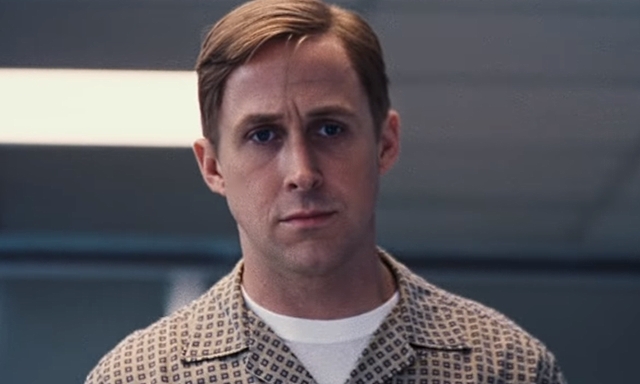
Frame from the film
Armstrong in the film is shown completely unemotional and completely immersed in the work. He does not look like a man so much that there are three possible versions - he is a robot (alas, not a bit of humor in the film), he is autistic (but then he wouldn’t be selected) or he has clinical depression (well explained by the death of his daughter, but, again , it would have been noticed and suspended from flying). Obviously, such traits were in his character - the sons in an interview emphasize that this is exactly what Neal was in life, and even the completely abnormal farewell scene with the children before the Apollo 11 flight is based on their memories. But the filmmakers obviously went too far, the story has preserved Armstrong's normal human emotionality. Here is the dialogue from the flight of "Gemini-8", when the ship went into orbit:
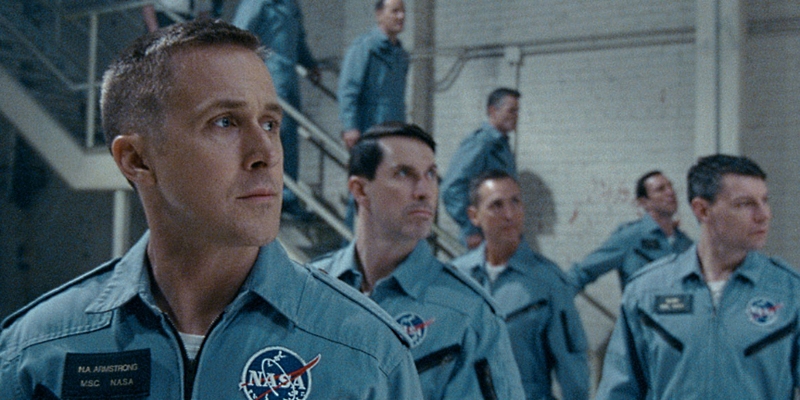
Frame from the film
Since we are talking about Aldrin, let's talk about the people who surround the main character. Collected astronauts are displayed poorly. They really do not represent, and you need to know well the composition of the US astronaut corps since the lunar race, including wives, in order to understand who you are shown, at best, calling them once by name. There are almost no noticeable characters - Ed White appears most often, he really was Armstrong's friend, Grissom and Slayton sometimes flash, Aldrin still appears, but he says nasty things and looks unpleasant. And this despite the fact that Aldrin flies on the Apollo 11 with Armstrong! Poor Collins, who was flying third, is called by name only in the module, and the viewer without training will hardly understand what kind of people fly with Neil to the Moon. Against this background, the social relations shown in Apollo 13 look like an unattainable ideal of clarity and positive.
The directorial vision of "Man on the Moon" struck me that it creatively borrows the "masterpiece" of Russian trash - the film "Paper Soldier". In the domestic picture on sunny Baikonur it is constantly raining, everything is damp and gloomy. In "Man on the Moon" the world is also shown dark, dull and gloomy. Seriously, even the start of the Apollo 11, which actually took place in sunny weather, was moved on a cloudy day.

Frame from the film
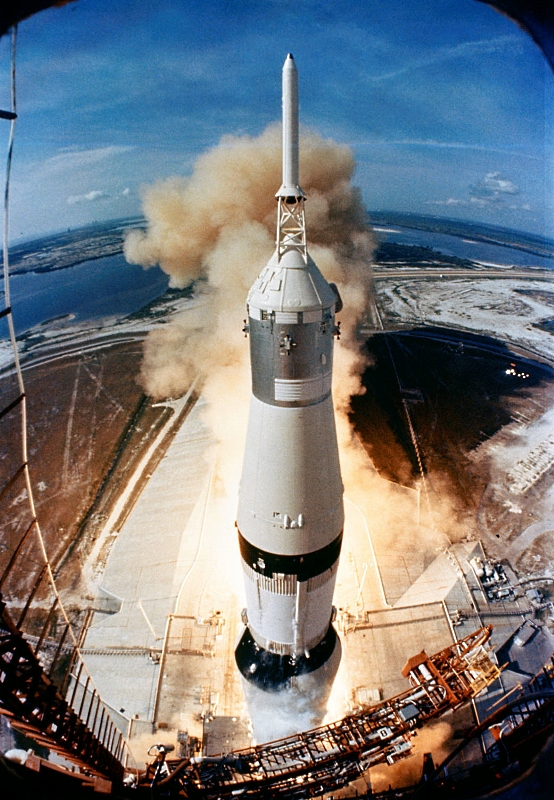
Real weather at the moment of launch, photo by NASA
It seems that the whole movie is only one sunny day. And the weather is not limited - the insides of the ships are dark, gloomy and for some reason even dirty. Where the dirt is in disposable ships, and why regular lighting does not work there, you need to ask the director “I see it that way”.
Also in the scene of the start of the Apollo 11, I was very angry that the staff of the MCC was thrown out of the frame, and the people who watched the start from the spectator grounds and just from the beach. There is an absurd feeling that the astronauts fly to the moon completely alone without any connection, help or empathy from the Earth. The ideal start was shown in Apollo 13, see how it should be removed:
The film honestly tries to follow real events, since they are well documented. But for unknown reasons, the sequence of actions is often shortened. In the scene of the landing on the moon, the installation of the flag was thrown out (because of which a scandal had already broken out in the USA), the launching scene ends at the first stage of the stage (and, secondly, the third one and two were still there). It is clear that the film turned out to be quite long, almost two and a half hours, but the discarded pieces were not superfluous.
Sometimes, perhaps for greater beauty, they recede from reality. "Gemini-8" rotated in two axes - the cause there was one non-working engine. In the film, the ship spun on all three axes, which is unrealistic. And this is despite the fact that the frames of the accident were completely preserved.
Filming
Real frames
In the moon landing scene, the surface was much better lit, and the deep crater shown in the film was not there either.
Video from Apollo 11
The only thing I liked about the film was the scene on the lunar surface. Shazella managed to convey a feeling from the moon, which the astronauts themselves called the “Magnificent desolation” - “the majestic wasteland”.
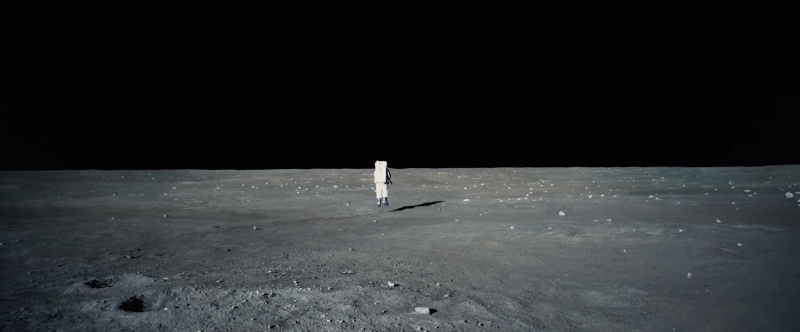
Frame from the film
The perception of art is a subjective thing, and some of my friends liked the movie. But personally, I am deeply disappointed and have already gathered to revise Apollo-13 for the next 100,500th time in order to enjoy a truly excellent film about astronautics.

It is difficult to call the spoilers biography of Armstrong, but, just in case, you were warned.
The biggest complaint
First of all - the picture confidently took the first place of my anti-rating of physical uncomfortable viewing. The camera is so mercilessly shaking that from the film really swayed! And if the shaking in scenes with aircraft and spacecraft can be attributed to an attempt to show a realistic vision of what happened, then the shaking domestic scenes have no rational explanation. As a result, my wife was forced to keep her eyes closed for more than half the film. I was hardier, but the whole movie felt distinct physical discomfort.
')
There is a feeling that Shazell decided to create a conceptual art house, deliberately taking it off his hands, at a time when every video blogger has a smartphone on a stabilizing gimbal. In general, looking ahead, the film lacks what it seemed to me to be signs of an arthouse. There is a second option - the director decided to prepare the audience for an astronaut career and made a vestibular apparatus test out of the picture. In any case, on the poster you should write a warning, like on a carousel.
Alien eyes
It so happened that the shortcomings of the film are revealed in the first scene of the flight on the X-15 and then just repeat.
First of all, Armstrong is shown very lonely. But the test or space flight is a joint effort of many people. The crew of the aircraft carrier, personnel on the ground - all these people are compressed to occasionally audible voices on the radio. The test flight of Chuck Yeager in “The Right Stuff” is shown much more correctly.
Further, the X-15 cab looks very unfriendly - there are windows on the screen from which nothing is clearly visible, incomprehensible devices and too often just a body with fastener elements is shown. It turns out psychologically unreliable image, because Armstrong studied the design and operating rules of the rocket plane, and the cabin for him should have been familiar and understandable. It seems that the X-15 is shown to us not by test pilot Armstrong, but by the humanities scriptwriter / director / operator.

Frame from the film

Real cabin X-15. Much cozier. Photo of US Air Force Museum
The world outside is no better - the solar stratosphere is shown to us as a gloomy and overcast day. Compare the footage from the film and the real chronicle of the flight of the X-15.

Frame from the film

A shot from the filming of the real X-15's onboard camera
And finally, what is happening in the film is understandable only to the boom, who understands the topic, because almost nothing is explained - what happens to whom and why. Some remarks, possibly degraded by translation, generally look like a mistake, and you need to specifically clarify in the sources in order to find out that in the film we are shown a badly retold real story.
Mystery rebound from the atmosphere
In the scene of a flight on the X-15, Armstrong itself begins to grow in height, and he is informed that he rebounds from the atmosphere. Since the speed of the suborbital rocket plane, this seems to be a serious mistake, since ballistics requires that, rising on a rocket engine over the dense layers of the atmosphere, but not going into orbit, the X-15 will go back. What was really?
The film shows 51 flights of the X-15, it is 3-4-8 (aircraft number 3, fourth flight, 8 taking into account towing and cancellations), which occurred on April 20, 1962. His goal was to test the adaptive control system MH-96. What is this system? The entire first half of the 20th century in aviation control was direct - the handle in the cockpit is connected by cables with control surfaces. This is simple, but has a serious drawback - at different speeds and flight modes, different efforts and movements of the knob are required to achieve the same effect. The MH-96 was an experimental system that was placed between the control stick in the cockpit and control surfaces on the wings and tail unit. Her task was to ensure the same reaction apparatus to move the handle, regardless of how much you need to move the control surface. Now such systems (EDSU) are on a variety of aircraft - airbuses, starting with the A320, Tu-204, Sukhoi Super Jet and the vast majority of military vehicles, but in the 1960s this was a new direction, and the X-15 flying in a large speed range and heights, was the perfect test bench.
Armstrong's mission in this flight was to check the MH-96 overload limiter. To prevent the rocket plane from falling apart in the air, the MH-96 had to independently control the X-15, reducing the overload. According to the plan, tested on the simulator, Armstrong had, after climbing, to hold the rocket glider up to about 15 ° with his nose. When descending, this would create an overload of 4-4.5 "same", sufficient to enable MH-96 to turn on and automatically lower the nose down. Initially, the flight went according to plan, and, rising to 63 km, Armstrong oriented the X-15 face up and waited. Alas, the simulation was incorrect - the adaptive control system did not turn on. And, since the X-15 is a winged vehicle, it, having a suborbital speed and a positive pitch angle, pushed its wings away from the dense layers of the atmosphere and really began to gain altitude. Having become a visual model of the Zenger bomber , the rocket flight with Armstrong could have flown far, but this was precisely what had to be avoided. The fact is that the X-15s landed on dry lakes, while Armstrong shifted from them all further south. Therefore, from the ground, the Nile was handed “We see that you are rising, not turning. Perform a steep left turn! ”But the rocket glider was outside the dense layers of the atmosphere, there was not enough air pressure to turn the device. After some time, going down below, Armstrong was able to deploy the X-15 in a sharp turn with an overload of 3 "same" and returned safely to the base. He even had a small reserve of height, the speed of which had to be extinguished by the release of brake flaps at the landing. But, of course, rumors have spread that Armstrong flew just meters above the houses of the village located south. A flight 3-4-8 was a record for the duration of the test program X-15.

Blue is a planned trajectory, red is a real reconstruction. A source
Returning to the film, we were correctly shown the events, but, without explanation, they look incomprehensible and implausible. Perhaps the filmmakers reproduced the dialogues verbatim, but it would be better for the on-screen Armstrong to comment on what was going on, since the pilot’s ongoing report is a logical and expected thing under test flight conditions.
Little known biography detail
The fact that the Armstrong family had a two-year-old daughter died of cancer is little known. The fact that he was reflected in the film is good and right, but instead of the emotional coloring of the life of the Hero of Humanity, something completely different happened. Memories of his daughter appear on the screen at critical moments, and the relationship with his wife is shown as problematic. And as a result, it begins to seem that the whole film is about how the father lost his daughter, and, along with her, the whole point of later life, in a completely incomprehensible way, in parallel becoming an astronaut and landed on the moon.
The final scene, when Armstrong leaves the bracelet of his dead daughter on the Moon, is based on the words of his sister June (June), indicated in the biography. She expressed the hope that Armstrong left something on the moon in memory of her daughter. At the end of the lunar surface, Armstrong stepped aside the crater of Little West and, theoretically, could perform this ceremony, despite a very tight schedule of actions on the moon. But there is no documentary evidence of this. By the way, Aldrin had a package with memorable things - Soviet medals in memory of the dead Komarov and Gagarin and the badges of the astronauts who died in the Apollo 1 crash. Because of the tight schedule, he almost forgot about him and threw aside the package already climbing the ladder of the lunar module.
Three bad choices and one important question.

Frame from the film
Armstrong in the film is shown completely unemotional and completely immersed in the work. He does not look like a man so much that there are three possible versions - he is a robot (alas, not a bit of humor in the film), he is autistic (but then he wouldn’t be selected) or he has clinical depression (well explained by the death of his daughter, but, again , it would have been noticed and suspended from flying). Obviously, such traits were in his character - the sons in an interview emphasize that this is exactly what Neal was in life, and even the completely abnormal farewell scene with the children before the Apollo 11 flight is based on their memories. But the filmmakers obviously went too far, the story has preserved Armstrong's normal human emotionality. Here is the dialogue from the flight of "Gemini-8", when the ship went into orbit:
Dave Scott: Hey, look at this look!But at least “Man on the Moon” answers one of my questions. I could not understand why, after the completion of his astronaut career, Armstrong began to live very closed. It looked especially bad against the background of Aldrin, who, like a clockwork one, is still worn around the world and popularizes astronautics. Well, the film gave the answer - Armstrong, by the nature of his character, was very withdrawn and unsociable. It is amazing that the fate of the icon of humanity fell to him.
Neil Armstrong: This is fantastic!
Scott: And they were right, right?
Armstrong: Great! Well, we give!
Void around

Frame from the film
Since we are talking about Aldrin, let's talk about the people who surround the main character. Collected astronauts are displayed poorly. They really do not represent, and you need to know well the composition of the US astronaut corps since the lunar race, including wives, in order to understand who you are shown, at best, calling them once by name. There are almost no noticeable characters - Ed White appears most often, he really was Armstrong's friend, Grissom and Slayton sometimes flash, Aldrin still appears, but he says nasty things and looks unpleasant. And this despite the fact that Aldrin flies on the Apollo 11 with Armstrong! Poor Collins, who was flying third, is called by name only in the module, and the viewer without training will hardly understand what kind of people fly with Neil to the Moon. Against this background, the social relations shown in Apollo 13 look like an unattainable ideal of clarity and positive.
Herman Jr. trail
The directorial vision of "Man on the Moon" struck me that it creatively borrows the "masterpiece" of Russian trash - the film "Paper Soldier". In the domestic picture on sunny Baikonur it is constantly raining, everything is damp and gloomy. In "Man on the Moon" the world is also shown dark, dull and gloomy. Seriously, even the start of the Apollo 11, which actually took place in sunny weather, was moved on a cloudy day.

Frame from the film

Real weather at the moment of launch, photo by NASA
It seems that the whole movie is only one sunny day. And the weather is not limited - the insides of the ships are dark, gloomy and for some reason even dirty. Where the dirt is in disposable ships, and why regular lighting does not work there, you need to ask the director “I see it that way”.
Also in the scene of the start of the Apollo 11, I was very angry that the staff of the MCC was thrown out of the frame, and the people who watched the start from the spectator grounds and just from the beach. There is an absurd feeling that the astronauts fly to the moon completely alone without any connection, help or empathy from the Earth. The ideal start was shown in Apollo 13, see how it should be removed:
Installation and decoration
The film honestly tries to follow real events, since they are well documented. But for unknown reasons, the sequence of actions is often shortened. In the scene of the landing on the moon, the installation of the flag was thrown out (because of which a scandal had already broken out in the USA), the launching scene ends at the first stage of the stage (and, secondly, the third one and two were still there). It is clear that the film turned out to be quite long, almost two and a half hours, but the discarded pieces were not superfluous.
Sometimes, perhaps for greater beauty, they recede from reality. "Gemini-8" rotated in two axes - the cause there was one non-working engine. In the film, the ship spun on all three axes, which is unrealistic. And this is despite the fact that the frames of the accident were completely preserved.
Filming
Real frames
In the moon landing scene, the surface was much better lit, and the deep crater shown in the film was not there either.
Video from Apollo 11
Magnificent desolation
The only thing I liked about the film was the scene on the lunar surface. Shazella managed to convey a feeling from the moon, which the astronauts themselves called the “Magnificent desolation” - “the majestic wasteland”.

Frame from the film
Conclusion
The perception of art is a subjective thing, and some of my friends liked the movie. But personally, I am deeply disappointed and have already gathered to revise Apollo-13 for the next 100,500th time in order to enjoy a truly excellent film about astronautics.
Source: https://habr.com/ru/post/427183/
All Articles